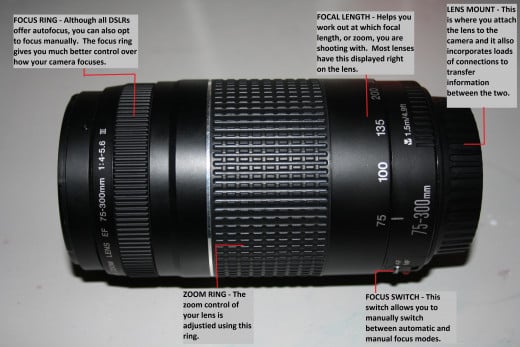Digital Camera Lenses and Focal Lengths
Lenses are a key part of your creative arsenal in photography. They allow you to crop in or zoom out and to frame and re-frame a composition to your hearts content. Lenses can help draw attention to a subject by blurring the background, or by keeping every detail sharp as far as the distant horizon. They can magnify distant subjects so they fill the frame or make them look quite small. They can squeeze a tall building into a single frame, even if you are standing right next to it. With the right lens on your camera, the whole world is your photographic plaything.
After you decide which DSLR camera is best for you, you can start buying all the fun lenses that go along with it.
The first thing you should know about a new lens for your DSLR camera are the parts of it and what all the numbers and letters mean.

Most lenses carry a series of letters and numbers on their barrels. These tell you the features and functions that the lens offers. Here's a guide to some of the terminology you will see on your lens.
- EF (Electronic Focus) - Used to denote Canon's range of autofocus lenses.
- EF-S (Electronic Focus, Short) - Digital-only lenses that have a short back focus for non-full frame DSLRs.
- IS (Image Stabilizer) - An in-lens system that detects camera shake and corrects it in the lens itself.
- USM (Ultra Sonic Motor) - A focus motor offering fast and quiet focusing.
- DO (Diffractive Optical element) - A combination of lens elements used to combat chrmoatic aberration (colour fringing) and reduce lens size.
- AF-D (Distance) - The lens supplies distance information to the camera to assist focusing.
- AF-I (Internal) - An internal autofocus motor used to speed up focusing.
- AF-G (Genesis) - Similar to AF-I but features a newer internal drive motor and lacks a manual aperture ring altogether. The G classification is to be found on most new models.
- AF-S (Silent) - These lenses feature a silent wave motor (SWM) which enables faster and quieter autofocus.
- IF (Internal Focus) - A system used so that the lens doesn't change length during focusing. This gives a more compact design, a non-rotating front element and a closer focusing distance.
- ED (Extra-low Dispersion) - A type of glass used to help reduce chromatic aberration (colour fringing) on lenses.
- VR (Vibrations Reduction) - A system of sensors and tiny gyros inside the lens to help minimize problems with camera shake.
- Micro - Nikon's term for macro. These lenses have a very short close focus distance allowing you to get very close to your subject.
- DX (Digital Only) - These lenses are for all Nikon's digital cropped-sensor DSLRs.
- FC (Full-Frame) - The latest DSLR sensor format from Nikon, with a sensor measuring around 36X24mm.

Focal Length
The focal length of your lenses are described in terms of their focal length, measured in millimeters, which in turn determines the lens's angle of view (how much of the scene you can get into frame). The shorter the focal length, the wider the angle of coverage. These are known as wide angle lenses. The longer the focal length, the narrower the angle of view. These are known as long or telephoto lenses.
The wide angle lens has the smallest focal length and allows you to get even more of the scene in your shots. You will notice that may wide angle lenses will overlap with the shorter end of your standard lens but the wide angle lens will usually go down to 10mm or 12mm at the shortest end for a greater angle of view.
Most DSLRs come supplied with a standard zoom lens. These lenses give you a range of focal lengths around 18-55mm. The lens is fine for most every day subjects such as landscape views, holidays and family outings.
18mm Zoom

24mm Zoom

55mm Zoom

Although any lens longer then 35mm can be classed as a telephoto lens, you will find that the focal lengths for most telephoto zooms start between 55mm to 75mm. This means they are the perfect complement to your standard lens, with hardly any overlap. At the longer end they usually go to either 200mm or 300mm, allowing you to pick out distant subjects and magnify them in your image.
100mm Zoom

200mm Zoom

300mm Zoom

A macro lens usually has a focal length of between 50mm and 105mm. The difference between macro and the normal telephoto lens is that macro lenses allow you to focus really close to the subject, allowing you to record small subjects such as flowers and insects at life-size magnifications.

When you are purchasing a new lens for your camera there are a few things you need to keep in mind.
- What focal length are you wanting to get?
- Which type of lens will best fit the needs you are looking for?
- Make sure the lens is the correct one for your camera (most lenses are not interchangeable with different cameras).
- You don't have to purchase every lens to get the picture you want.









